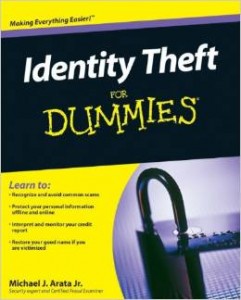
Buy Identity Theft for Dummies on Amazon
Identity theft can completely screw up your life. About 10 million Americans get their identities stolen every year, and the average cost of an identity theft is over $5,000 — not even considering the lost time and hassle.
While it’s possible to use high-tech methods to steal your personal information, there are some low-tech methods commonly used. Here are 4 things that you have some control over that can greatly reduce the chance of having your identity stolen using common low-tech methods.
1) Avoid Mail Theft
Stealing from your mailbox is a federal felony, yet mail thieves are rarely caught, and it’s one of the main ways that an identity thief has to get your personal information. At the very least, learn when your mailman normally delivers, and be sure to gather your mail as soon as it comes.
If you can’t be there to get your mail when the postman delivers it, seriously consider getting either a PO box, or a private mail box (PMB). A PO box is less expensive than a PMB, but a PMB can be much more convenient. I got a PMB for about $150/year, but I also have UPS deliveries there, which you can’t get with a PO box.
Another alternative is to buy a locking mailbox. Here’s a good one from Amazon, but you can probably find one at a local hardware store.
2) File Your Taxes Early
The earlier you file your income tax, the less chance an identity thief has to beat you to it. It can take over a year to straighten out your taxes if somebody files a fraudulent tax return in your name. You might even find yourself fighting criminal charges if that happens.
Another detail to consider: If you write a check for taxes due, be sure to write “Internal Revenue Service” on the check, and not “IRS.” The latter can be easily altered to “TRS” or “NRS” and deposited in an account opened with that name. By the time you find out what happened (and the real IRS is threatening you with penalties for non-payment), the thief will have closed the account and vanished.
One more item on taxes. If you don’t prepare your taxes yourself, use a tax preparer who is licensed and bonded. After all, you have to provide a tax preparer with everything needed for a successful identity theft.
3) Get Regular Credit Reports
You can get free credit reports annually from the 3 major reporting agencies. However, once a year is probably not enough. Credit tracking services are not terribly expensive, and may save you considerable agony.
You can also register with each of the major credit reporting agencies to have a “lock” placed on your account. This makes it less convenient for you to apply for credit yourself, but it is pretty effective at blocking fraudulent credit applications with your name by somebody else.
This last tactic, by the way, is just one of many used by the LifeLock company. LifeLock is more than just a credit monitoring service. They help protect your personal information using a combination of data surveillance techniques.
4) Never Give Personal Information to a Phone Caller
That should be pretty obvious, but it’s amazing how many people will give out enough information to enable an identify theft to somebody who calls on the phone. I would recommend that you don’t even give your name to a caller, no matter who he says he is.
Incidentally, you should also get into the habit of NEVER saying “yes” to an unknown person even if you made the call. Sometimes a scammer will record and splice a conversation to make it seem like you agreed to something that you did not.
Even if you have caller ID, the name and number you see on your phone is actually easy to spoof. It’s certainly not legal, but like mail theft, it’s a very common crime that is rarely caught and punished.
If I don’t recognize the caller ID, I just let my answering machine take it. That screens out about 95% of the scammers.
Summary
This article only covers a few methods commonly used to steal personal information, mostly common low-tech methods.
High-tech methods are a very different topic, which may require several blog posts. And, in my opinion, there isn’t enough protection available against high-tech methods.
For a much broader coverage of the topic, I recommend the book, Identity Theft for Dummies, shown at the top of this article.









